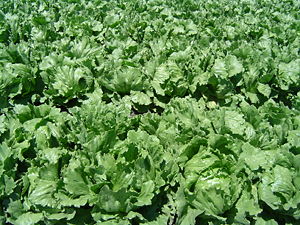March means more fresh locally grown fruits and vegetables at your neighborhood grocery store and farmer’s market. One that is often overlooked is lettuce. Even though it shows up on the sandwiches and in salads we eat nearly every day, lettuce rarely shows up in the limelight.
Here in Arizona, we celebrate lettuce, especially from November through March when 90% of the nation’s lettuce come from Yuma, Arizona. No wonder they call that special little spot in southern Arizona the “Lettuce bowl capitol of the nation!”
This month, let’s take a look at some of the little known facts about lettuce.
Part of the sunflower family called Asteraceae, lettuce is a hardy, annual plant that is easily cultivated in many climates. The ancient Egyptians were the first to see this plant as more than a weed with valuable seeds. Once cultivation began, the leafy green vegetable quickly spread across the ancient world. Throughout the centuries, lettuce has been used to fill plates, treat and cure ailments, to make oil, and for religious uses.
The origin of this leafy green’s name goes all the way back to ancient Rome. The Roman word for lettuce was lactuca, which provided the root for the French term letues, which evolved into the term we use today. Likewise, romaine, a kind of lettuce, gets its name from the Roman gardens where this type was grown. References to the three most common types of lettuce grown today, head, loose leaf, and romaine, can be found in medieval writing although most references indicate its use in herbal remedies.
Lettuce plants come is a wide variety of shapes and textures. Average size plants range from 6 to 12 inches in both height and width. It can take as long as 130 days to grow some varieties of lettuce from seed to harvest, although other varieties can be ready to pick in less than half that time. In order to preserve the flavor of many varieties, plants cannot grow to maturity as once they flower the leaves become bitter and inedible.
There are several common types of lettuce grown today including:
- Iceberg or Crisphead lettuce – This is the most popular type of lettuce in the U.S. and grows in tightly wrapped round heads and is one of the most common type grown in winter in Yuma.
- Loose leaf or leaf lettuce which is also called cutting or bunching lettuce – Most commonly used in salads, this is the most common type of lettuce grown today. It is characterized by its structure of loose bunches of leaves.
- Romaine lettuce – Most commonly used in Caesar salads, this type of lettuce grows in tall, elongated heads.
- Bibb, Boston, or Butterhead lettuce – Similar in structure to the loose leaf varieties, this type of lettuce is known for its sweeter flavor.
Although lettuce is most commonly used as a base for salads, it is also used on sandwiches and can be a great addition to many different recipes. This month when you are at the local farmer’s market or perusing the produce at the grocery store, pick-up a couple varieties and try some of these great recipes where lettuce is the star of the show.
- Asian Lettuce Wraps
- Chicken Lettuce Wraps
- Chopped Medjool Date Salad
- Crunchy Apple Salad
- Goat Cheese Lettuce Wraps
- Green Salad
- Grilled Romaine with Creamy Balsamic Vinaigrette
- Join the Party Salad
- Rasher or Buckboard Bacon Burger
- T-A-B-L-E Cosmos
- Tostados
Related articles
- 7 Tips for Eating Your Way to More Energy (fillyourplate.org)
- 4 Tips to Eat Right in the New Year (fillyourplate.org)
- Filling Your Plate With Healthy Food Might Actually Save You Money (fillyourplate.org)


